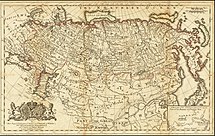Poltavka culture: Difference between revisions
No edit summary |
Added genetic study |
||
| Line 22: | Line 22: | ||
What significantly distinguishes it from the Yamnaya culture are changes in pottery and an increase in metal objects. [[Tumulus]] [[inhumation]]s continue, but with less use of [[ochre]]. |
What significantly distinguishes it from the Yamnaya culture are changes in pottery and an increase in metal objects. [[Tumulus]] [[inhumation]]s continue, but with less use of [[ochre]]. |
||
In a 2015 study published in [[Nature (journal)|Nature]], the remains of six individuals ascribed to the Poltavka culture were analyzed. Five of the individuals were determined to belong to various subclades of [[Haplogroup R1b#R1b1a2 (R-V88)|haplogroup R1b1a2]], while one individual, who belonged to the outliers of the culture, was determined to belong to [[Haplogroup R1a#R1a1a1b2 (R-Z93) (Asia)|R1a1a1b2a]].<ref>{{cite journal |last1=Mathieson |first1=Iain |author-link1= |last2= |first2= |author-link2= |date=December 24, 2015 |year= |orig-year= |editor1-last= |editor1-first= |editor1-link= |others= |title=Genome-wide patterns of selection in 230 ancient Eurasians |trans-title= |url=https://www.ncbi.nlm.nih.gov/pmc/articles/PMC4918750/ |access-date= |url-access= |format= |department= |journal=[[Nature (journal)|Nature]] |type= |series= |language= |edition= |location= |publisher= |publication-place= |publication-date= |volume=528 |issue=7583 |page= |pages=499-503 |at= |bibcode= |bibcode-access= |doi=10.1038/nature16152 |doi-access= |doi-broken-date= |isbn= |jstor= |archive-url= |archive-date= |url-status= |via= |quote= |ref=harv}}</ref> |
|||
It was succeeded by the [[Srubna culture|Srubna]] and [[Sintashta culture]]. It is presumptively early [[Indo-Iranians|Indo-Iranian]] ([[Proto-Indo-Iranian language|Proto-Indo-Iranian]]), possibly representing a late satem dialect of [[Proto-Indo-European language|Proto-Indo-European]]. |
It was succeeded by the [[Srubna culture|Srubna]] and [[Sintashta culture]]. It is presumptively early [[Indo-Iranians|Indo-Iranian]] ([[Proto-Indo-Iranian language|Proto-Indo-Iranian]]), possibly representing a late satem dialect of [[Proto-Indo-European language|Proto-Indo-European]]. |
||
Revision as of 13:02, 23 September 2019
 | |
| Geographical range | Russia, Kazakhstan |
|---|---|
| Period | Bronze Age |
| Dates | c. 2700 BCE – 2100 BCE |
| Preceded by | Yamnaya culture, Catacomb culture, Sintashta culture |
| Followed by | Srubna culture, Sintashta culture |
| Part of a series on |
| Indo-European topics |
|---|
 |
| History of Russia |
|---|
 |
|
|
| Bronze Age |
|---|
| ↑ Chalcolithic |
| ↓ Iron Age |
Poltavka culture (Russian: Полтавкинская культура), 2700—2100 BCE, an early to middle Bronze Age archaeological culture of the middle Volga from about where the Don-Volga canal begins up to the Samara Bend in Russia, with an easterly extension north of present Kazakhstan along the Samara River valley to somewhat west of Orenburg.
Together with the Catacomb culture it is the successor of the Yamnaya culture, while also succeeded by the Sintashta culture.[1] It seems to be an early manifestation of the Srubna culture. There is evidence of influence from the Maykop culture to its south.
What significantly distinguishes it from the Yamnaya culture are changes in pottery and an increase in metal objects. Tumulus inhumations continue, but with less use of ochre.
In a 2015 study published in Nature, the remains of six individuals ascribed to the Poltavka culture were analyzed. Five of the individuals were determined to belong to various subclades of haplogroup R1b1a2, while one individual, who belonged to the outliers of the culture, was determined to belong to R1a1a1b2a.[2]
It was succeeded by the Srubna and Sintashta culture. It is presumptively early Indo-Iranian (Proto-Indo-Iranian), possibly representing a late satem dialect of Proto-Indo-European.
References
- ^ Полтавкинская культура – Большая русская энциклопедия (БРЭ). Т.26. Москва, 2016
- ^ Mathieson, Iain (December 24, 2015). "Genome-wide patterns of selection in 230 ancient Eurasians". Nature. 528 (7583): 499–503. doi:10.1038/nature16152.
{{cite journal}}: Invalid|ref=harv(help)
Sources
- J. P. Mallory, "Poltavka Culture", Encyclopedia of Indo-European Culture, Fitzroy Dearborn, 1997.
